![[Maastricht]](../images/maastricht.gif)
Concise History of the City
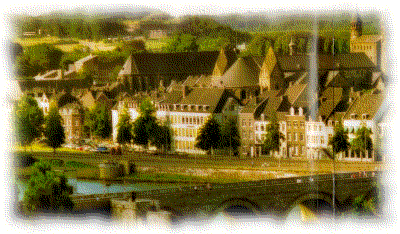 The history of Maastricht goes back to c. 50 B.C., when the Romans built a
settlement by the main road, near a ford in the river. The city's name is
derived from the Latin 'Mosae Trajectum', the site where the Meuse could be
crossed. This settlement grew to become a walled castellum, which was abandoned
towards the end of the fourth century A.D.
The history of Maastricht goes back to c. 50 B.C., when the Romans built a
settlement by the main road, near a ford in the river. The city's name is
derived from the Latin 'Mosae Trajectum', the site where the Meuse could be
crossed. This settlement grew to become a walled castellum, which was abandoned
towards the end of the fourth century A.D.
From c. 380 to 722 A.D. Maastricht was a bishop's see. Saint Servatius, who
died in 384, was the first and Saint Hubert the last bishop. The latter
transferred the bishop's see to Liege whilst retaining his prerogatives in the
town. As from 1202 Maastricht was ruled jointly by the Duke of Brabant and the
Prince-Bishop of Liege. The rights and privileges of both lords temporal and
ecclesiastical were laid down in the so-called 'Aide Caerte' (1284), and this
situation continued until 1795.
Maastricht had its first outer walls built in 1229. Before long the town
was felt to be too cramped, and at the beginning of the 14th century
construction work on a new series of walls was commenced. Maastricht has had to
withstand many sieges; because of the Meuse crossing it was an important town
strategically, and Dutch, Spanish and French armies laying siege to Maastricht
frequently. During 1795 the occupying French forces took drastic measures,
making Maastricht the capital of a French province, the Departement of the
Lower Meuse.
After Napoleon's defeat at Waterloo, Belgium and the
Netherlands became a united kingdom under King William 1. After battling for
nine years (1830-1839) the two countries went their own separate ways; thanks
partly to the intervention of General Dibbets, Maastricht remains a Dutch city.
In 1867 Maastricht lost its role as a fortress; the city started on a new period
of expansion.
Maastricht now
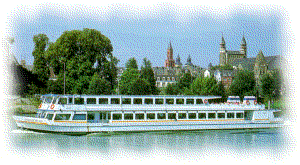 Maastricht nowadays has about 120.000 inhabitants and an area of 5896 ha. The
city lies on the rivers Meuse and Jeker, at the foot of Mount St. Peter. The
major economic activities are commerce, services and industry (e.g. pottery,
glass, paper and cement). Post-secondary educational facilities include a
college for translation studies, a conservatory and a hotel school.
Maastricht nowadays has about 120.000 inhabitants and an area of 5896 ha. The
city lies on the rivers Meuse and Jeker, at the foot of Mount St. Peter. The
major economic activities are commerce, services and industry (e.g. pottery,
glass, paper and cement). Post-secondary educational facilities include a
college for translation studies, a conservatory and a hotel school.
The centre of the city is especially attractive, due to its wealth of
historic buildings; some 1450 monuments are protected by law. Care is taken
that both new and renovated buildings maintain the period atmosphere of their
surroundings. Because of its heritage value, the whole of Maastricht city
centre has been declared a 'protected area'. We therefore thoroughly recommend
a city walk.
On the southern side of the city (Randwyck) a new economic centre has been
built, with exhibition halls, a conference centre, provincial building,
academic hospital and office facilities. A new central district is located on
the river Meuse: Céramique site. Until a short time ago, the site was
home to the potteries of the Societé Céramique, from which the
project has taken its name. Céramique will be a unique combination of
dwellings, offices, shop, parks and the Bonnefantenmuseum. A dynamic district,
delineated by the chief supervisor of the plan, the dutch architect Jo Coenen.
A number of European institutes have already been set up in the city, e.g. the
European Institute of Public Administration and the European Centre for Work
and Society. Countless people visit the city to shop around in the various
shopping centres or to taste of the convivial Burgundian atmosphere. Access is
excellent, whether you are travelling by car, rail, bus or air. Maastricht
Airport is a modern terminal, with flight departures several times a day to
places like Amsterdam and London. In addition, the airport fulfils an important
role in the tourist (charter), freight and sport sectors.
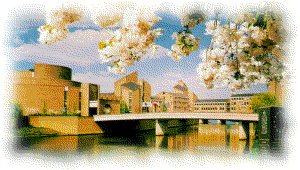 Since 1991 Maastricht has been well known throughout the world as the city
whose name will always be closely linked to the unification of Europe. The
half-yearly summit conference of the European Council, which was held in this
city on 9 and 10 December 1991 under the chairmanship of the Netherlands,
resulted in the "Treaty of Maastricht". This laid the foundation for the
political, economic and monetary integration of Europe.
Since 1991 Maastricht has been well known throughout the world as the city
whose name will always be closely linked to the unification of Europe. The
half-yearly summit conference of the European Council, which was held in this
city on 9 and 10 December 1991 under the chairmanship of the Netherlands,
resulted in the "Treaty of Maastricht". This laid the foundation for the
political, economic and monetary integration of Europe.
An architectural tour de force, it is build on the banks of the River Meuse
and partly on an island. The section on the bank is open to the public at
all times, and is well worth a visit. The conference of the Council of
Europe was held in this building on 9 and 10 December 1991. Visitors may
look around the administrative section from Monday to Friday (9 a.m. to 12 a.m.
and 2 p.m. to 4 p.m.
Historic Buildings
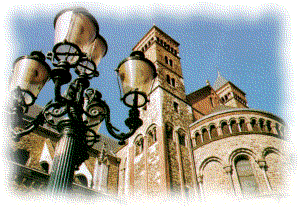 Basilica of Saint Servatius, Keizer Karelplein, Vrijthof square.
Basilica of Saint Servatius, Keizer Karelplein, Vrijthof square.
Medieval cruciform basilica, the heart of which dates from c. 1000. Crypts
(11th and 12th century). The only church in the Netherlands
built above the grave of a saint. St. Servatius, the first bishop of the
Netherlands. The romanesque west side with Emperor's Gallery and Hall. The
Cathedral was considerably enlarged in the 14th and 15th century. Beautiful
entrance decorated with statuettes (Berg Portal and Keizer Karelplein
entrance). The largest bell in The Netherlands hangs in the Southern tower of
the west wall; it is called 'Grameer' (Grandmother) and weighs 7000 kg. In the
cathedral stands a statue of Charlemagne. A treasure-house with an important
collection of religious art objects. Church and treasury can be visited.
Basilica of Our Beloved Lady, O.L. Vrouweplein.
Medieval cruciform basilica of which the oldest part (west wing and crypts)
dates from the 11th century. The church has been enlarged and
altered during different periods. The west wing as well as the choir are
architecturally important and are the only ones of their kind. The capitals
surrounding the choir are richly sculpted ('Heimo-Kapitelen', 2nd
half of 12th century). In the side chapel the pilgrim's statue of
Our Beloved Lady 'Stelia Mare' (c. 1500). Church and treasury can be visited
but not during services.
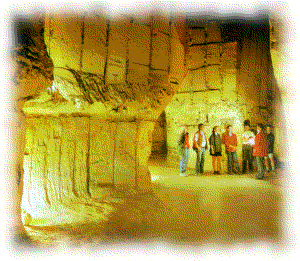 Caves of Mount St. Pieter
Caves of Mount St. Pieter
The famous 'St. Pietersberg' caves are the result of centuries of excavation
of marl, a building stone. What we now see is an enormous labyrinth of more
than 20,000 passages. The stone-hewers have left their marks. On the walls
are interesting inscriptions, some extremely old; artists too, have been at
work here. During the many sieges Maastricht has suffered, and also during the
last world war, local inhabitants used the passages as a shelter; some of the
emergency provisions are still to be seen. The temperature in the caves is
9-10 degrees Ceicius; visitors are therefore advised to take a cardigan, pullover
or coat with them. The round-trips, which last about an hour, are led by
official VVV Tourist Office guides. Two sections of the labyrinths of Mount
St. Pieter are open to the public.
![[Go to: Index]](../images/but_index2.gif)
![[Maastricht]](../images/maastricht.gif)
![[Maastricht]](../images/maastricht.gif)
 The history of Maastricht goes back to c. 50 B.C., when the Romans built a
settlement by the main road, near a ford in the river. The city's name is
derived from the Latin 'Mosae Trajectum', the site where the Meuse could be
crossed. This settlement grew to become a walled castellum, which was abandoned
towards the end of the fourth century A.D.
The history of Maastricht goes back to c. 50 B.C., when the Romans built a
settlement by the main road, near a ford in the river. The city's name is
derived from the Latin 'Mosae Trajectum', the site where the Meuse could be
crossed. This settlement grew to become a walled castellum, which was abandoned
towards the end of the fourth century A.D.
 Maastricht nowadays has about 120.000 inhabitants and an area of 5896 ha. The
city lies on the rivers Meuse and Jeker, at the foot of Mount St. Peter. The
major economic activities are commerce, services and industry (e.g. pottery,
glass, paper and cement). Post-secondary educational facilities include a
college for translation studies, a conservatory and a hotel school.
Maastricht nowadays has about 120.000 inhabitants and an area of 5896 ha. The
city lies on the rivers Meuse and Jeker, at the foot of Mount St. Peter. The
major economic activities are commerce, services and industry (e.g. pottery,
glass, paper and cement). Post-secondary educational facilities include a
college for translation studies, a conservatory and a hotel school.
 Since 1991 Maastricht has been well known throughout the world as the city
whose name will always be closely linked to the unification of Europe. The
half-yearly summit conference of the European Council, which was held in this
city on 9 and 10 December 1991 under the chairmanship of the Netherlands,
resulted in the "Treaty of Maastricht". This laid the foundation for the
political, economic and monetary integration of Europe.
Since 1991 Maastricht has been well known throughout the world as the city
whose name will always be closely linked to the unification of Europe. The
half-yearly summit conference of the European Council, which was held in this
city on 9 and 10 December 1991 under the chairmanship of the Netherlands,
resulted in the "Treaty of Maastricht". This laid the foundation for the
political, economic and monetary integration of Europe.
 Basilica of Saint Servatius, Keizer Karelplein, Vrijthof square.
Basilica of Saint Servatius, Keizer Karelplein, Vrijthof square. Caves of Mount St. Pieter
Caves of Mount St. Pieter